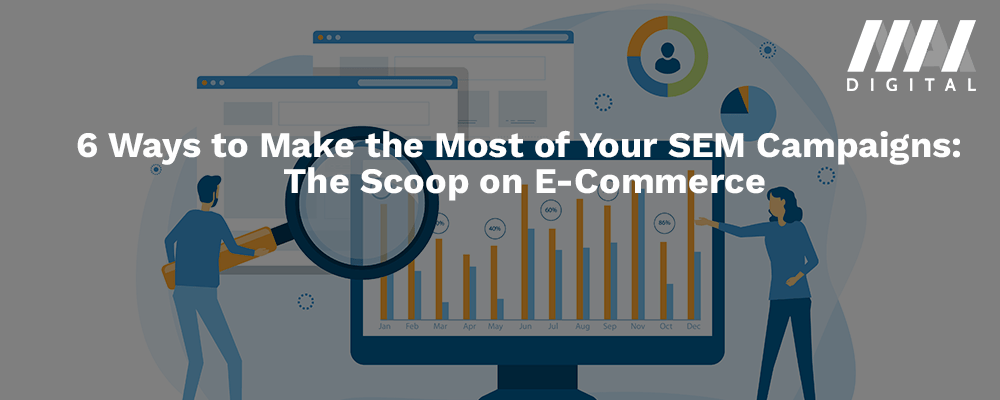
Let’s face it—we’re living in a digital world. The internet is an integral part of our lives, and that includes the way we shop. If you have an eCommerce website and want to stay on top, you must always be thinking about how to optimize your SEM campaigns and make sure your campaign goals align with the future of eCommerce.
SEM stands for “search engine marketing.” It is a way to promote your business by running ads on search engines. These ads typically show up when people are looking for information about products and services that you offer. SEM can be an effective way to increase visibility, customer conversion rates, and revenue. However, it can also be expensive if not done correctly. In this blog post, we’ll explore six key ways that will help you work smarter and not harder!
Optimizing Sales Through a Landing Page
The best-performing SEM campaigns need to be personalized, but not all landing pages are the same. A customized page will generate greater conversion possibilities and avoid confusion with search terms through relevant content for each user’s needs. When customers come to your site, you want to make sure that they know exactly what they’re getting and the benefits of purchasing from you. This way, you can maximize sales and reach customers who are more likely to buy from you again in the future. The right landing page will convert more customers and help you rank higher in search engines.
Video Marketing for SEM Campaigns
The most interesting SEM tactics are those who take the format of video. Most advertisers limit themselves to text links or banners. Still, an engaging video offers many conversion possibilities for eCommerce brands—not forgetting that Google owns YouTube and could promote you simultaneously! Video marketing has been one of the most effective ways to reach and engage your customers these days. Online videos can be spread virally through social media channels, efficiently driving traffic back to your site. Videos also allow you to communicate with your customers in an informal way which they can relate to more than traditional advertising. Plus, subtitled videos give your brand more accessibility and are a great way keep your audience interested until the end.
Automating SEM Campaigns
Content is king- but what if creating that content was completely automated? If you’re struggling with generating relevant blog posts and web pages, consider using a content management system (CMS). A CMS allows you to set up templates automatically populated by data from various sources- all without even having to log into your site’s web interface. With an automated tool, advertisers can run successful campaigns that include new product tracking and season-based changes. SEM is perfect for this because of its ability to automate bidding, which will ultimately save time setting up the campaign and provide quality score optimization, so you don’t have any worries about what your ads are doing online!
Avoiding Keyword Inflation
The click-through rate is an essential measure of relevance because it tells Google that people find your ad relevant and valuable. As a result, the higher it will be ranked at a lower cost!
The voice of your company should be the first thing that potential customers hear. Check to see if there are keywords or phrases out on the market being used by competitors, then find new ways for them not only to talk about their product but show how it can help people solve problems they might have as well! This will make you stand apart from other businesses in an increasingly competitive marketplace where one inch ahead could mean miles ahead. Advertising through paid search can be a great way to test out specific keywords. You’ll notice quick results, which allow for trial and error when testing these terms. This is a beneficial tool if your campaigns are producing conversions at a reduced rate. This way, you can adjust your keywords and get the most out of your marketing dollars!
Organizing Ad Groups
When running an SEM campaign, you have to monitor dozens of keywords, phrases, ads, and landing pages at any given time. Keeping track of everything that’s going on in your campaign can be overwhelming- especially when you have to change budgets or bids on the fly. We recommend creating ad groups that separate your marketing efforts by key components to getting more out of SEM. This allows you to make changes in one area without affecting the other parts of your campaign.
Managing URL Structure
Your ads must always be working and not broken. The links in each ad should take people directly to a specific page where you’re selling the product, which will ensure their attention stays on-site for as long as possible. Redirecting from homepages can cause visitors time wasted trying to navigate through pages until they find what they’re looking for or abandon altogether!
Another thing is that many marketers use long URLs like http://www.example-longurl.com to save characters in their blog posts or social media updates; however, this is hurting their page rankings! Google prefers short URLs because they’re easier for users to remember and share with friends via email and social media. We recommend using URL shorteners like Bitly to keep your URLs clean and easy to read!
Conclusion
To sum it up, automated SEM campaigns are great for creating new ads and managing keywords to ensure the highest ROI possible. A CMS will allow you to create content without doing it yourself while also promoting your company’s voice. Optimizing landing pages, ad groups, and URL structure and their budget will help them achieve quality score optimization so they can focus on other business areas!
Mitch is an experienced eCommerce Project Manager specializing in delivering seamless online experiences and driving digital growth. With expertise in project planning, platform optimization, and team collaboration, Mitch ensures every eCommerce initiative exceeds expectations. Passionate about innovation and results, Mitch helps businesses stay ahead in the dynamic digital landscape.

